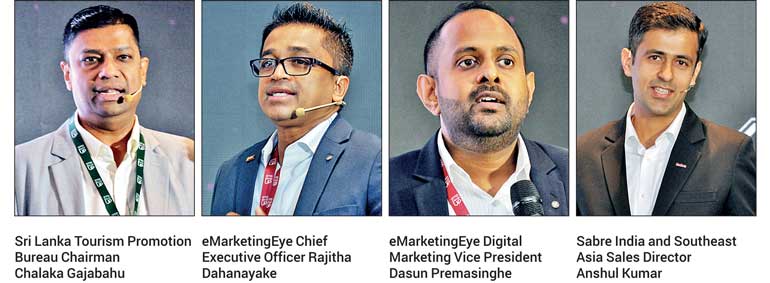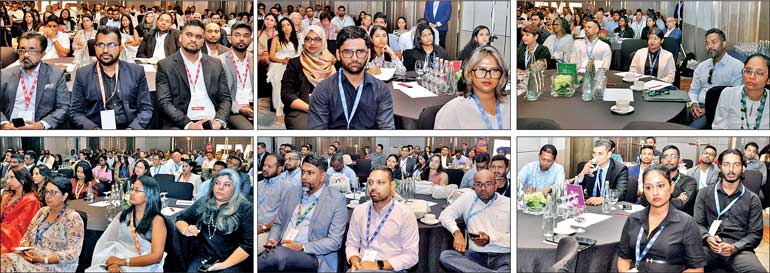Monday Apr 14, 2025
Monday Apr 14, 2025
Tuesday, 20 August 2024 00:10 - - {{hitsCtrl.values.hits}}


By Divya Thotawatte
As Sri Lanka’s tourism surges to its highest since 2018, the country has entered the ranks of the top hotel searches, but they should cater to the growing demand for digital planning of personalised stays, experts stressed recently.
This discussion took place at the EME Level-Up: Digital Hospitality Conclave, an invite-only conference held exclusively for hospitality industry professionals by eMarketingEye (EME), an award-winning digital marketing agency in Sri Lanka. The conference hosted 200+ delegates and 20+ local and international speakers who joined over 15 sessions throughout the day.
Sri Lanka Tourism Promotion Bureau (SLTPB) Chairman Chalaka Gajabahu said that while 2018, with 2.3 million tourist arrivals, was the best year for Sri Lankan tourism since the 30-year civil war, the same target has been set for 2024 as Sri Lanka recovers from the “black mark” of the economic crisis. While there were a significant 1.49 million tourist arrivals last year, by 31 July 2024, Sri Lanka was already at 1.2 million, he said.
To achieve these targets, a brand identity campaign was needed in addition to the already-in-action Seeing is Believing campaign. “We have to come up with a proper campaign and strategy to do that. Through a procurement process and tender process, Ogilvy Sri Lanka won the brand strategy and creative development campaign. The first phase is an interim digital campaign, the second is a destination positioning campaign and the third, the high-end traveller campaign,” Gajabahu noted, highlighting the importance of a suitable online marketing and PR campaign for Sri Lanka.
Sri Lankan accommodation is also significant to this brand-building and growth of the country’s tourism, where in turn, it creates more opportunities for the local brands.
“When you talk about hotel search evolution, Sri Lanka, Japan, Maldives, UK, Australia, US and UAE has actually taken over,” said Lighthouse Indian Subcontinent Business Development Mohammad Abdul Ahad, while Google Travel Ads Specialist Joanna Ong also stated that the demand for Sri Lanka was rising in 2024 with specifically, more Google suggestions for accommodations.
While the post pandemic traveller is online “all the time” and uses more than 140 touchpoints when researching brands that they have not previously used, there was an opportunity for Sri Lankan brands to connect with these travellers.
“If you tailor your digital strategy to reach out to these travellers, you will have a greater chance of being in the consideration and purchased. We know that pent up travel demand is the real thing and we are seeing strong indicators that people are planning major life moments that were put on hold. For example, we know that 38% of international leisure travellers say that they are more likely to plan or book a once in a lifetime trip than ever before.”
She explained that another trend among these travellers was that they invested more time in planning trips. Coming out of the pandemic era, they sought to ease the increased work that was associated with taking a trip by now investing more time and effort into planning their trips than they did before for an effortless experience during the trip. “All this is to ensure that the next trip that they take is thoughtfully chosen and curated. Currently, we see that digital is winning over travellers in general.
There is also a significant group, especially amongst young travellers, who are less loyal and more open to try out new brands. This means that competition to win back customers and gain new customers will be very high, giving travel brands a second chance to make a first impression. Travellers want to build relationships with brands that meet their expectations for seamless personal life travel and brands that give them a best in class experience.”
“Invest in your direct channel”
Personalisation is increasingly sought after today and consumers seek products and brands that resonate with them. “They want a convenience and seamless experience and they want it now so that it’s bookable, it’s portable, and they can carry it with themselves,” said Sabre India and Southeast Asia Director of Sales Anshul Kumar.
According to research done by Deloitte and American Express Travel, similar trends were seen in travel where 60% of the travellers sought personalised experiences and 77% cared more about the right experiences than the cost of the trip.
However, hotel sites fail to offer a satisfactory booking experience. “If I click on the book button, it usually takes me into the calling of the hotel or it takes me to a mail to a link where I need to converse with the hotel. If I want to surprise my wife with a bottle of champagne or a lovely cake in the room, I will have to call the hotel or maybe, mail them and do all of those back and forth communication in order to make it happen. It’s a broken journey pretty much today.
People are coming to your website, people are looking at your posts and videos of your hotels that are going viral. They absolutely want to book directly, but they’re moving away.”
Therefore, in attracting this new traveller who values experience over expenses, hotels should invest in and modernise their direct channel, through which 50% of their bookings were made. Personalised offers or upgrades could happen at the booking stage, the pre stay level, during the stay, or when they are leaving. Activities, personalised souvenirs, are all important, said Kumar.
EME Digital Marketing Vice President Dasun Premasinghe also explained, “Your website is the cornerstone of your digital strategy because it helps you to get higher with no commissions and you get to get the maximum of your revenue. You can build a loyal customer base, build long term relationships with them and also in return, have the chance of upselling and continuously increasing your repeat business at a very low cost per acquisition.”
While being visible and available on all the touch points that travellers are present, brands should, therefore, follow a fool proof booking strategy. The brands should establish the basics by having a SEO-friendly, seamlessly built and well-designed website that also maintains clarity on offers, cancellation policies, etc. to establish trust and credibility.
Then, map the entire digital strategy to the customer journey with different channels and mediums that would allow the brand to effectively cater to each stage of the purchase cycle, while ensuring that the brand has a personalised approach to reach those audiences. The integration of AI into the overall strategy and data-driven decision-making were the next important things, Premasinghe shared.
Discover Kapruka, the leading online shopping platform in Sri Lanka, where you can conveniently send Gifts and Flowers to your loved ones for any event including Valentine ’s Day. Explore a wide range of popular Shopping Categories on Kapruka, including Toys, Groceries, Electronics, Birthday Cakes, Fruits, Chocolates, Flower Bouquets, Clothing, Watches, Lingerie, Gift Sets and Jewellery. Also if you’re interested in selling with Kapruka, Partner Central by Kapruka is the best solution to start with. Moreover, through Kapruka Global Shop, you can also enjoy the convenience of purchasing products from renowned platforms like Amazon and eBay and have them delivered to Sri Lanka.
Discover Kapruka, the leading online shopping platform in Sri Lanka, where you can conveniently send Gifts and Flowers to your loved ones for any event including Valentine ’s Day. Explore a wide range of popular Shopping Categories on Kapruka, including Toys, Groceries, Electronics, Birthday Cakes, Fruits, Chocolates, Flower Bouquets, Clothing, Watches, Lingerie, Gift Sets and Jewellery. Also if you’re interested in selling with Kapruka, Partner Central by Kapruka is the best solution to start with. Moreover, through Kapruka Global Shop, you can also enjoy the convenience of purchasing products from renowned platforms like Amazon and eBay and have them delivered to Sri Lanka.